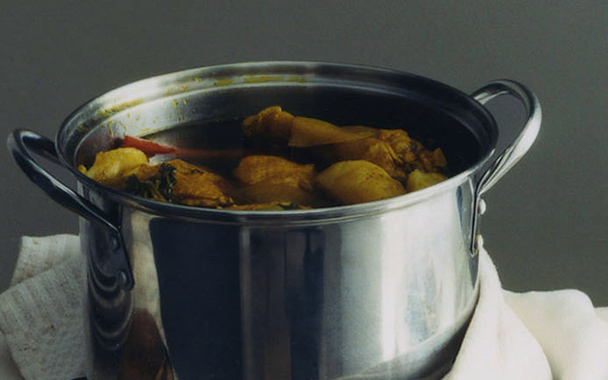Not so long ago I came home while my wife, Tara, was absorbed in putting our baby to bed. I hadn’t had an idea of what to make for dinner, but Tara apparently had: The Terra cookbook was on the kitchen table, open to a recipe for a spicy garlic soup. It was the work of just a few moments: I tossed some bread cubes with olive oil, paprika, and minced garlic to make croutons, then lightly browned a couple more cloves of minced garlic in a larger pot, added more paprika and cayenne off the heat, then poured in a quart of chicken stock and brought it to a simmer. I poached a couple of eggs and left them waiting in bowls with the croutons, and when Tara emerged, I poured in the soup. The broth had a toasty, sharp kick from the garlic and a hot kick from the peppers, both of which were tamed by the soft egg, the texture of which contrasted with the crunchy-but-softening croutons. A simpler and more satisfying winter supper may not exist—but I wouldn’t have bothered with the soup had there not been homemade chicken stock in the freezer.
A stock is a clear liquid that’s been flavored by cooking things in it. In Japanese dashi those things are dried fish and/or kelp (hello, umami), but the European tradition calls for vegetables and perhaps fish, poultry, or meat. Stocks act as a dish’s foundation, bringing a depth of flavor and tying all the other ingredients together. A good stock works a lot like the right amount of salt, underlining and emphasizing in a best-supporting-actor kind of way.
The stock I use most often is chicken stock, which is most naturally made in one-chicken batches. Start with a stewing chicken—an old hen who’s stopped producing eggs, for example—or a collection of backs, wings, and other miscellaneous parts. (Farmers selling eggs at the market will have the former; your local butcher will have the latter.) Rinse them well; cover them with a couple inches of cold water (four to six quarts’ worth should do it); and bring the whole thing to just below a simmer. There should be a bubble from the bottom every second or so. As the stock cooks a foam will form from various proteins; skim this off carefully and frequently. After an hour or so add your vegetables—a couple of quartered onions, a few carrots, and some celery—cut into very large pieces with the skins still on. (The onion skin in particular makes the stock a nice golden brown.) Now is the time to add aromatics, too: a bouquet garni or half a bunch of parsley, a dry bay leaf or two, a pinch of whole peppercorns. (Salting usually waits until the finished dish.) Simmer everything together for another couple of hours until you have a rich essence of chicken. Then strain it and, for safety, chill it as quickly as possible (I often set the container with strained stock in a sink full of ice water). Leave it overnight in the fridge so the fat solidifies, then portion it into quarts and put it in the freezer.
You’ll find that you can go through stock pretty quickly, especially in winter, between soups, braises, and risottos. These dishes will taste better and you’ll have the satisfaction of reveling in the quiet craft of cooking.




 Pinterest
Pinterest


